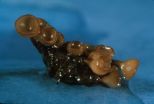(Press-News.org) In about 40 percent of research participants undergoing medical imaging, radiologists may detect a tumor or infection unrelated to the study but that may be meaningful to the individual's health, according to a report in the September 27 issue of Archives of Internal Medicine, one of the JAMA/Archives journals.
"An incidental finding in human subjects research is defined in a major consensus project as an observation 'concerning an individual research participant that has potential clinical importance and is discovered in the course of conducting research, but is beyond the aims of the study,'" the authors write as background information in the article. "Numerous reports have detailed how the detection of an incidental finding can result in the early beneficial diagnosis of an unsuspected malignant neoplasm or aneurysm. However, others describe harm and excessive cost resulting from treatment of radiographically suspicious incidental findings. Moreover, clinical experience dictates that many incidental findings are of indeterminate clinical significance and generate uncertainty among both research participants and their physicians."
Nicholas M. Orme, M.D., of Mayo Clinic, Rochester, Minn., and colleagues evaluated the medical records of 1,426 research participants who underwent an imaging procedure related to a study conducted in 2004. Each image was interpreted by a radiologist the day it was performed, and an expert panel reviewed all incidental findings that resulted in a clinical action during a three-year follow-up period.
Of the 1,426 research imaging examinations, an incidental finding occurred in 567 (39.8 percent). The risk of an incidental finding increased with age. More incidental findings were generated in patients undergoing computed tomography (CT) scans of the abdomen and pelvic area than in any other imaging procedure, followed by CT of the chest and magnetic resonance imaging (MRI) of the head.
Clinical action was taken for 35 (6.2 percent) of the individuals with an incidental finding; in most cases (26 of 567, or 4.6 percent) the medical benefit or burden of these actions was unclear. However, action resulted in clear medical benefit for six of the 567 patients (1.1 percent) and clear medical burden in three patients (0.5 percent).
"This study demonstrates that research imaging incidental findings are common in certain types of imaging examinations, potentially offering an early opportunity to diagnose asymptomatic life-threatening disease, as well as a potential invitation to invasive, costly and ultimately unnecessary interventions for benign processes," the authors write. "The majority of incidental findings seem to be of unclear significance. These instances represent a dilemma for researchers."
The findings should help researchers identify imaging studies at high risk for generating incidental findings and develop a plan for managing them, the authors conclude. "Timely, routine evaluation of research images by radiologists can result in identification of incidental findings in a substantial number of cases that can result in significant medical benefit to a small number of patients," they write.
(Arch Intern Med. 2010;170[17]:1525-1532. Available pre-embargo to the media at www.jamamedia.org.)
Editor's Note: Please see the article for additional information, including other authors, author contributions and affiliations, financial disclosures, funding and support, etc.
Editorial: Researchers Must Plan for Incidental Findings
"In clinical research, investigators may learn information about a participant that is not pertinent to the research question but that may have important clinical implications for the participant," writes Bernard Lo, M.D., of the University of California, San Francisco, in an accompanying editorial. "Such incidental findings present ethical dilemmas. Although they may offer the possibility of substantial personal benefit to the participant, more commonly they are false-positive findings that lead to a cascade of testing that presents additional risks and burdens."
"When planning a study, researchers need to develop a comprehensive plan for how they will respond to incidental findings, including what findings they will offer to disclose to participants," Dr. Lo continues. "The possibility of incidental findings, and their ramifications, should be part of the informed consent process. The work by Orme et al helps us to start to quantify their impact."
(Arch Intern Med. 2010;170[17]:1522-1524. Available pre-embargo to the media at www.jamamedia.org.)
Editor's Note: Dr. Lo is supported by a National Institutes of Health grant from the National Center for Research Resources and NIH Roadmap for Medical Research and by the Greenwall Foundation. Please see the article for additional information, including author contributions and affiliations, financial disclosures, funding and support, etc.
###
END
An intensive lifestyle intervention appears to help individuals with type 2 diabetes lose weight and keep it off, along with improving fitness, control of blood glucose levels and risk factors for cardiovascular disease, according to a report in the September 27 issue of Archives of Internal Medicine, one of the JAMA/Archives journals.
Improving blood glucose control and cardiovascular risk factors in patients with type 2 diabetes is critical in preventing long-term complications of the disease, according to background information in the article. Emphasis has been placed ...
While both black patients and white patients appear to benefit from end of life discussions with their physician, black patients are less likely to experience end-of-life care that accurately reflects their preferences, according to a report in the September 27 issue of Archives of Internal Medicine, one of the JAMA/Archives journals.
"Although black patients are also more likely than white patients to desire life-prolonging measures, receipt of life-prolonging care at the end of life is associated with greater distress and with poorer quality of life," the authors write ...
Home-based exercises followed by voluntary home training seem to be associated with long-term effects on balance and gait (manner of walking), and may help protect high-risk, elderly women from hip fractures, according to a report in the September 27 issue of Archives of Internal Medicine, one of the JAMA/Archives journals.
"Falls are responsible for at least 90 percent of all hip fractures," the authors write as background in the article. "Hip fractures place the greatest demands on resources and have the greatest effect on patients because they are associated with high ...
Use of pine bark extract, at a dose of 200 milligrams per day, appears safe but did not improve risk factors for heart disease, according to a report in the September 27 issue of Archives of Internal Medicine, one of the JAMA/Archives journals.
"Although traditional strategies such as prescription medications, dietary changes and physical activity have proven benefits for reducing cardiovascular disease risk, a substantial population seeks alternative therapies, including various dietary supplements, to lower cardiovascular disease risk," the authors write as background ...
ANN ARBOR, Mich.---The more complex a plant or animal, the more difficulty it should have adapting to changes in the environment. That's been a maxim of evolutionary theory since biologist Ronald Fisher put forth the idea in 1930.
But if that tenet is true, how do you explain all the well-adapted, complex organisms---from orchids to bower birds to humans---in this world?
This "cost of complexity" conundrum puzzles biologists and offers ammunition to proponents of intelligent design, who hold that such intricacy could arise only through the efforts of a divine designer, ...
Software downloaded during a routine office visit cuts the risk of inappropriate shocks by 50 percent for patients with implantable cardioverter defibrillators (ICD), according to research reported in Circulation: Journal of the American Heart Association.
"Hundreds of patients have been saved from unnecessary shocks by software that is safe and can be painlessly downloaded in one minute during a standard defibrillator check," said Charles D. Swerdlow, M.D., lead author of the study and a cardiac electrophysiologist at the Cedars Sinai Heart Institute in Los Angeles and ...
Using data from more than 270,000 hospital stroke admissions, scientists have identified how to predict which patients are at greatest risk of dying in the hospital after stroke. Before their study, well validated models to predict in-hospital death risk after stroke were lacking, the researchers reported in Circulation: Journal of the American Heart Association.
"A mortality risk assessment tool for hospitalized stroke patients is important to clinicians, hospitals and patients," said Eric E. Smith, M.D., M.P.H., lead author of the study and assistant professor of neurology ...
VIDEO:
In a few tenths of a second, Sclerotinia expels hundreds of thousands of spores in a plume that can rise 20 cm, much higher than any single spore by itself....
Click here for more information.
Long before geese started flying in chevron formation or cyclists learned the value of drafting, fungi discovered an aerodynamic way to reduce drag on their spores so as to spread them as high and as far as possible.
One fungus, the destructive Sclerotinia sclerotiorum, ...
In a paper published this week in the Proceedings of the National Academy of Sciences, Cary Institute aquatic ecologist Dr. Emma Rosi-Marshall and colleagues report that streams throughout the Midwestern Corn Belt are receiving insecticidal proteins that originate from adjacent genetically modified crops. The protein enters streams through runoff and when corn leaves, stalks, and plant parts are washed into stream channels.
Genetically-modified plants are a mainstay of large-scale agriculture in the American Midwest, where corn is a dominant crop. In 2009, more than ...
Burness Communications
Godwin Atser
g.atser@cgiar.org
234-803-443-0027
CGIAR
Scientists arrive in Senegal to give African hunger a black eye
At the World Cowpea Research Conference, crop experts embrace one of agriculture's oldest legumes -- prized for protein and resilience to hot, dry climates -- as food for people, livestock and astronauts
This release is available in French.
DAKAR, SENEGAL (27 September 2010)—A long neglected crop with the potential to halt hunger for millions in Africa, sustain the livestock revolution underway in developing countries, ...

